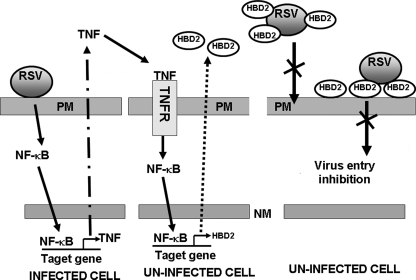FIGURE 9.
A schematic diagram depicting a model for HBD2-mediated innate antiviral response. RSV infection of lung epithelial cells results in induction of NF-κB and extracellular secretion of TNF. TNF via paracrine fashion will engage with TNF receptor (TNFR) of uninfected cells to activate NF-κB leading to induction and secretion of HBD2. The progeny viruses released from the infected cells will fail to infect neighboring cells (thus limiting virus spread) productively because of the restriction in viral entry by extracellular HBD2. Entry is inhibited because of direct binding of soluble extracellular HBD2 with the virion particles, causing destabilization of viral envelope. The HBD2 bound to the extracellular domain of plasma membrane may also interact with the virion particles to destabilize the virion envelope and thus inhibit entry. PM, plasma membrane; NM, nuclear membrane; TNFR, TNF receptor.

